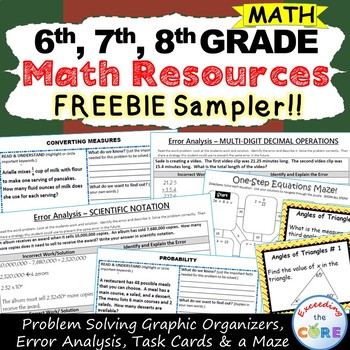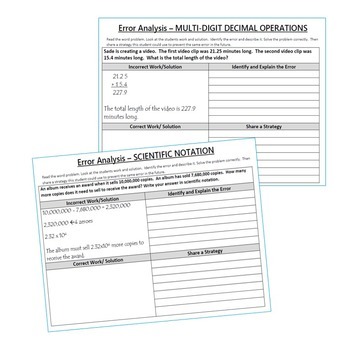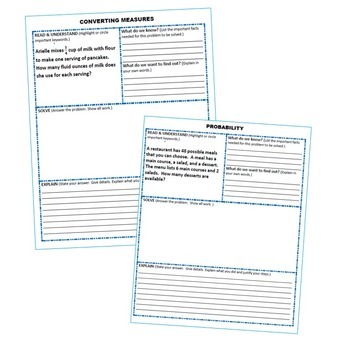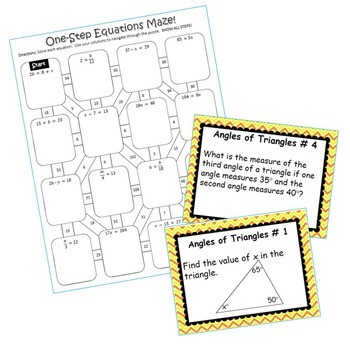Exceeding the CORE
6k Followers
Grade Levels
6th - 8th
Subjects
Resource Type
Standards
CCSS8.G.A.5
CCSS7.SP.C.5
CCSS7.SP.C.6
CCSS7.SP.C.7
CCSS7.SP.C.8
Formats Included
- PDF
- Easel Activity
Pages
10 pages
FREE
Exceeding the CORE
6k Followers
Easel Activity Included
This resource includes a ready-to-use interactive activity students can complete on any device. Easel by TPT is free to use! Learn more.
Description
6th Grade, 7th Grade, 8th Grade Math Resources ~ Milestone FREEBIE - Task Cards, Graphic Organizers, Error Analysis, Maze
I have reached a major milestone on TpT and I would like to thank all of my loyal customers for making this amazing dream come true! I have enjoyed sharing my teaching materials with you, and I'm thrilled to celebrate this milestone with all of you.
This FREEBIE includes 4 task cards, 3 problem solving graphic organizers, 3 error analysis activities, and 1 maze (over 25 skills practice and real-world word problems). The resources in this FREEBIE are perfect for warm-ups, cooperative learning, spiral review, math centers, assessment prep and homework.
This FREEBIE includes sample pages from the following resources:
*** 6th Grade Resources ***
✔ Decimals Error Analysis
✔ Converting Measures Problem Solving Graphic Organizer
✔ One Step Equations Maze
*** 7th Grade Resources ***
✔ Integers Error Analysis
✔ Probability Problem Solving Organizer
*** 8th Grade Resources ***
✔ Scientific Notation Error Analysis
✔ Multi-Step Equations Problem Solving Graphic Organizer
✔ Angles of Triangles Task Cards
_______________________________________________________________________
Get more resources like these in my MATH MEGA BUNDLES & save 25%.
* 6th Grade Math MEGA BUNDLE
* 7th Grade Math MEGA BUNDLE
* 8th Grade Math MEGA BUNDLE
Get it ALL in my Middle School MATH GROWING BUNDLE & save 30%.
If you would like to get updates on NEW and CURRENT resources...
FOLLOW the Exceeding the Core BLOG!
FOLLOW me on Teachers Pay Teachers!
FOLLOW me on Pinterest!
© Exceeding the CORE. All rights reserved. Please note - this resource is for use by one teacher only. Additional teachers must purchase their own license. Copying, editing, selling, redistributing, or posting any part of this product on the internet is strictly forbidden. Violations are subject to the penalties of the Digital Millennium Copyright Act.
I have reached a major milestone on TpT and I would like to thank all of my loyal customers for making this amazing dream come true! I have enjoyed sharing my teaching materials with you, and I'm thrilled to celebrate this milestone with all of you.
This FREEBIE includes 4 task cards, 3 problem solving graphic organizers, 3 error analysis activities, and 1 maze (over 25 skills practice and real-world word problems). The resources in this FREEBIE are perfect for warm-ups, cooperative learning, spiral review, math centers, assessment prep and homework.
This FREEBIE includes sample pages from the following resources:
*** 6th Grade Resources ***
✔ Decimals Error Analysis
✔ Converting Measures Problem Solving Graphic Organizer
✔ One Step Equations Maze
*** 7th Grade Resources ***
✔ Integers Error Analysis
✔ Probability Problem Solving Organizer
*** 8th Grade Resources ***
✔ Scientific Notation Error Analysis
✔ Multi-Step Equations Problem Solving Graphic Organizer
✔ Angles of Triangles Task Cards
_______________________________________________________________________
Get more resources like these in my MATH MEGA BUNDLES & save 25%.
* 6th Grade Math MEGA BUNDLE
* 7th Grade Math MEGA BUNDLE
* 8th Grade Math MEGA BUNDLE
Get it ALL in my Middle School MATH GROWING BUNDLE & save 30%.
If you would like to get updates on NEW and CURRENT resources...
FOLLOW the Exceeding the Core BLOG!
FOLLOW me on Teachers Pay Teachers!
FOLLOW me on Pinterest!
© Exceeding the CORE. All rights reserved. Please note - this resource is for use by one teacher only. Additional teachers must purchase their own license. Copying, editing, selling, redistributing, or posting any part of this product on the internet is strictly forbidden. Violations are subject to the penalties of the Digital Millennium Copyright Act.
Total Pages
10 pages
Answer Key
Included
Teaching Duration
1 Year
Report this resource to TPT
Reported resources will be reviewed by our team. Report this resource to let us know if this resource violates TPT’s content guidelines.
Standards
to see state-specific standards (only available in the US).
CCSS8.G.A.5
Use informal arguments to establish facts about the angle sum and exterior angle of triangles, about the angles created when parallel lines are cut by a transversal, and the angle-angle criterion for similarity of triangles. For example, arrange three copies of the same triangle so that the sum of the three angles appears to form a line, and give an argument in terms of transversals why this is so.
CCSS7.SP.C.5
Understand that the probability of a chance event is a number between 0 and 1 that expresses the likelihood of the event occurring. Larger numbers indicate greater likelihood. A probability near 0 indicates an unlikely event, a probability around 1/2 indicates an event that is neither unlikely nor likely, and a probability near 1 indicates a likely event.
CCSS7.SP.C.6
Approximate the probability of a chance event by collecting data on the chance process that produces it and observing its long-run relative frequency, and predict the approximate relative frequency given the probability. For example, when rolling a number cube 600 times, predict that a 3 or 6 would be rolled roughly 200 times, but probably not exactly 200 times.
CCSS7.SP.C.7
Develop a probability model and use it to find probabilities of events. Compare probabilities from a model to observed frequencies; if the agreement is not good, explain possible sources of the discrepancy.
CCSS7.SP.C.8
Find probabilities of compound events using organized lists, tables, tree diagrams, and simulation.






